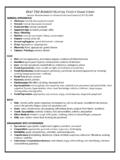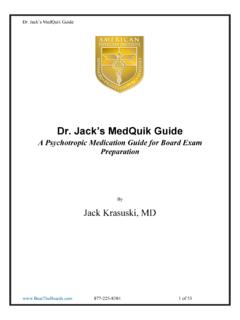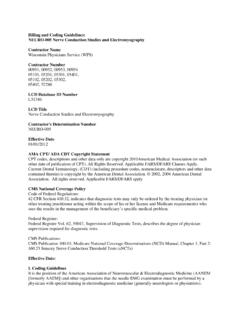Transcription of EMG Cheat Sheet - Beat the Boards!
1 EMG Cheat Sheet Basics of EMG: Despite the countless number of causes, there are only 4 pathologic responses to nerve injury: 1. Primary neuronal degeneration or neuronopathy 2. Segmental demyelination 3. Wallerian degeneration in response to axonal interruption 4. Axonal degeneration or axonopathy The goal when evaluating a patient with a neuropathy is to place them into one of these four categories, based on the history and physical examination, and then to use the EMG/NCS to confirm the clinical suspicion. The clinical context is always the most important factor. There are few accepted normative values for EMG/NCS. Any test must give normal values. Axonal Neuropathy: drop in amplitude Demyelinating Neuropathy: slowing of conduction velocity Myopathic units: early recruitment of small, polyphasic units Neuropathic units: reduced recruitment or large units Basic Patterns: 1.
2 Neuronopathies: Involve diseases of the anterior horn cell (motor neuronopathies) or dorsal root ganglion (sensory neuronopathies). There are no conditions that affect both. a. Motor Neuronopathies (ALS, Spinal Muscular Atrophy, Polio) Clinical Findings Muscle loss with fasciculations, muscle weakness, hyper (ALS) or hypo (SMA) reflexia, normal sensory examination Sensory NCS (SNAP) Normal Motor NCS (CMAP) Reduced CMAP amplitudes, normal-to-borderline distal latency, normal-to-mildly slowed conduction velocity Needle Examination Prominent spontaneous activity (positive waves and fibrillations), usually in multiple myotomes (even those that do not appear clinically affected Recruitment Reduced recruitment of large MUAPs Other The EMG often appears worse than the patient, esp early on. Sensory abnormalities in a younger male patient suggest X-linked Spinal Bulbar Muscular Atrophy (Kennedy s Disease) b.)
3 Sensory Neuronopathies Clinical Findings Diffuse non-length dependent sensory loss (the face and arms may be involved early), early gait ataxia (helps differentiate from a chronic sensory neuropathy), areflexia, normal muscle bulk, tone and strength Sensory NCS (SNAP) Absent or severely reduced. If present, radial SNAP may be worse than sural SNAP (non-length dependent). Motor NCS (CMAP) Normal (though distal latency may be mildly prolonged) Needle Examination Normal Recruitment Normal Other Conditions affecting the DRG are rare (paraneoplastic (anti-Hu, CRMP5), autoimmune (Sjogrens), paraprotein (ganglioside Abs), vitamin (B6 toxicity), toxic (cis-plantin). The proximal root and/or dorsal column can appear hyperintense on spine imaging. 2. Segmental demyelination: Demyelination is associated with marked slowing of conduction velocity (CV) (slower than 75% of the lower limit of normal), marked prolongation of distal latency (longer then 130% of the upper limit of normal) or both.)
4 In general, any motor, sensory or mixed nerve study slower than 35 m/s in the arms or 30 m/s in the legs signifies demyelination. conduction block and temporal dispersion are associated with acquired demyelination (and should not be present in hereditary conditions such as Charcot-Marie-Tooth). Criteria for conduction block varies by lab and by stimulus site, but >30% drop in amplitude or >50% drop in area usually defines electrophysiologic conduction block. Clinical Findings Muscle weakness often with normal muscle bulk, sensory loss, areflexia Sensory NCS (SNAP) Absent, or small and slow (* can be normal in multifocal motor neuropathy with conduction block) Motor NCS (CMAP) Reduced CMAP amplitudes, prolonged distal latencies (>130% ULN), markedly slowed conduction velocities (<75% LLN) Needle Examination Early: No denervation 2- 5 weeks: Fibrillation potentials appear 6- 10 weeks: Max fibrillation potentials (and may persist for months) Recruitment Early: Reduced recruitment of normal appearing MUAPs Other Borderline CV values need to be interpreted in the context of CMAP and SNAP amplitudes.
5 Completely normal amplitudes with borderline CVs suggests a demyelinating process; severely reduced amplitudes with borderline CVs suggests a primary axonal process. 3. Wallerian Deneration in response to Axonal Interruption: This include a broad category of disorders, including focal mononeuropathies (median neuropathy at the wrist (ie, carpal tunnel syndrome)), radiculopathies (focal impingment upon the nerve root), +/- plexopathies, and vasculitis/mononeuritis multiplex. a. Median Neuropathy at Wrist (eg, Carpal Tunnel Syndrome) Clinical Findings Atrophy of the thenar eminence, sensory loss digits 1-3, nocturnal paresthesias, wrist pain Sensory NCS (SNAP) Absent to reduced amplitude and slowed conduction velocity Motor NCS (CMAP) Prolonged distal latency (> ms in many labs), reduced amplitude, normal-to-borderline CV, prolonged F-wave latency compared to the ulnar response Needle Examination Normal (thenar muscles, if tested, may show evidence of denervation) Recruitment Reduced recruitment (if tested) Other a.
6 Median mixed nerve response (orthodromic conduction recording at the wrist) may be the first abnormality and can be tested in patients for whom there is a high clinical suspicion b. Median to ulnar comparison recording over digit 4 (which receives dual innervation) can be helpful to confirm CTS (prolonged peak or onset latency of > ms) b. Radiculopathy Clinical Findings Muscle loss (fasciculations may be present), muscle weakness, reduced corresponding reflex, +/- sensory abnormality, pain Sensory NCS (SNAP) Normal (the DRG is uninvolved or distal to the lesion) Motor NCS (CMAP) Often normal, though in chronic cases there may be a reduced CMAP amplitude, normal-to-borderline distal latency, normal-to-mildly slowed conduction velocity, and prolonged F-wave latency Needle Examination Below Recruitment Below Other There may be selective fascicular involvement and not all muscles will be affected b.
7 Time Course Acute Decreased recruitment of normal appearing MUAPs in clinically weak muscles Day 10-14 Fibrillation potentials and positive waves develop in paraspinal muscles Day 14-21 Fibrillation potentials and positive waves develop proximal muscles supplied by the nerve root Day 21-28 Fibrillation potentials and positive waves develop in distal muscles supplited by the nerve root Chronic (2-3 months) Large amplitude, long-duration polyphasic MUAPs, diminishment of fibrillation potentials (also occurs in a proximal-to-distal fashion) c. Plexopathy Clinical Findings Prominent pain, muscle weakness (may be myotomal in proximal lesions (above the clavicle) or reflect a mononeuropathy in distal (below the clavicle) lesions), areflexia Sensory NCS (SNAP) Reduced to absent (plexus lesions are distal to the DRG, unlike radicular lesions) Motor NCS (CMAP) May have reduced amplitude; less useful than sensory studies (median and ulnar CMAPs only reflect C8-T1 fibers) Needle Examination Abnormalities in the distribution of the affected part of the cord Recruitment Reduced (similar to radiculopathy) Other Myokymic discharges are characteristic of radiation-induced plexopathy.
8 Side-to-side comparison may be important for diagnosis. Absence of axonal continuity (absent CMAP, profuse denervation, no MUAPs activated despite good effort) is an ominous sign and surgical exploration, nerve graft, or tendon transfer may be considered. Neuropraxia Nerve dysfunction lasting hours to 6 months after blunt injury. The axon and connective tissue remains intact. Recovery usually occurs within a few weeks. Axonotmesis Physical interruption of axons within an intact epineurium. Clinical deficits depend on how many axons are involved. Axonal disruption leads to Wallerian degeneration. Neurotmesis Complete interruption of the entire nerve the axons and all connective tissue structures. Axonal disruption leads to Wallerian degeneration. 4. Axonal Degeneration: Garden variety neuropathies usually caused by diffuse afflictions of the nerve, most commonly caused by metabolic derangements.
9 Clinical Findings Distal muscle atrophy (the EDB is almost always reduced or absent), absent ankle jerks (are the rule), paresthesias, sensory loss Sensory NCS (SNAP) Absent to reduced sural amplitude with borderline conduction velocities Motor NCS (CMAP) Normal to mildly prolonged distal latencies, reduced amplitudes, borderline conduction velocities. Needle Examination Normal or with evidence of spontaneous activity Recruitment Reduced recruitment or normal Other Findings are usually relatively symmetric. Recommended labs include Vitamin B12 (with or without MMA), SPEP, and blood glucose testing (routine, GTT, etc). Common Source of Error Skin temperature Slows CV and increases amplitude Age Slows CV and decreases amplitude Height Prolongs F-waves, can drop amplitude and CV (longer, thinner nerves) Stimulus Can stimulate adjacent nerves; change in wave pattern


